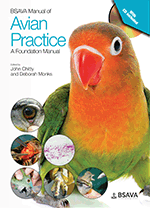
Full text loading...

This chapter gives a sound foundation in avian reproduction, to provide the clinician with the necessary tools to work-up and diagnose reproductive problems, and then to treat them. Common issues discussed include egg binding, yolk peritonitis, gonadal neoplasia, excessive egg laying, aggression and fertility and production problems in breeding facilities.
Reproduction, Page 1 of 1
< Previous page | Next page > /docserver/preview/fulltext/10.22233/9781910443323/9781910443323.4-1.gif

Full text loading...


















